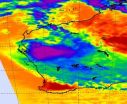(Press-News.org) MANHATTAN, KAN. -- Two Kansas State University researchers focusing on rice genetics are providing a better understanding of how pathogens take over a plant's nutrients.
Their research provides insight into ways of reducing crop losses or developing new avenues for medicinal research.
Frank White, professor of plant pathology, and Ginny Antony, postdoctoral fellow in plant pathology, are co-authors, in partnership with researchers at three other institutions, of an article in a recent issue of the journal Nature. The article, "Sugar transporters for intercellular exchange and nutrition of pathogens," was led by Li-Qing Chen from the department of plant biology in the Carnegie Institution for Science at Stanford University.
The project involves the identification a family of sugar transporters, called SWEETS, which transport glucose between plant cells. These transporters are also important because they are targeted by pathogens trying to obtain plant sugar for nutrition.
"It's remarkable," White said. "These bacteria are able to regulate the plant genes directly by inserting proteins into the plant cells. The proteins take over the transcription of the SWEET gene, and the plant, as a consequence, becomes susceptible to bacterial disease."
White and Antony focused specifically on rice bacterial disease and tried to understand what makes rice susceptible and what makes it resistant to specific pathogens. The K-State researchers discovered three resistance genes in rice that can be mutated in order to build the resistance of the rice against a pathogen. One of these resistance genes -- Xa13 -- is included in the Nature article and was discovered by White's lab in 2006.
"We've identified the genes that bacteria can induce to cause the plant to be susceptible," White said. "We've identified them as critical for disease from a pathogen standpoint. For the plant, these genes are involved in normal development. However, once the pathogen takes control of expression, it makes the plant susceptible."
White and Antony also have an article appearing in the December issue of the journal The Plant Cell. They collaborated with researchers from Iowa State University to investigate a second susceptibility gene and its role in the spread of disease.
White's laboratory has been working on such rice research for 15 years, but started collaborating with the Stanford researchers earlier this year.
"We have been trying to understand what the pathogen wants from the host, how the pathogen gets it, and how the host tries to defend itself," Antony said.
Although the research is important in the field of plant genetics, it has broader applications as well. Because researchers have a better understanding of how to control pathogen food supplies, they can use this research to reduce crop diseases and subsequent losses. The plant research may also apply the findings to humans or animals because both use similar sugar transporter genes to transfer glucose, leading to new possibilities for medicine and diabetes research.
White and Antony are in the midst of a three-year, $3-million National Science Foundation grant, and have also been funded in their research by the U.S. Department of Agriculture's National Research Initiative program through the Cooperative State Research, Education and Extension Service.
INFORMATION: END
Like a fence or barricade intended to stop unwanted intruders, the skin serves as a barrier protecting the body from the hundreds of allergens, irritants, pollutants and microbes people come in contact with every day. In patients with eczema, or atopic dermatitis, the most common inflammatory human skin disease, the skin barrier is leaky, allowing intruders – pollen, mold, pet dander, dust mites and others – to be sensed by the skin and subsequently wreak havoc on the immune system.
While the upper-most layer of the skin – the stratum corneum – has been pinned as the ...
50 million years ago, mountains began popping up in southern British Columbia. Over the next 22 million years, a wave of mountain building swept (geologically speaking) down western North America as far south as Mexico and as far east as Nebraska, according to Stanford geochemists. Their findings help put to rest the idea that the mountains mostly developed from a vast, Tibet-like plateau that rose up across most of the western U.S. roughly simultaneously and then subsequently collapsed and eroded into what we see today.
The data providing the insight into the mountains ...
Computer games and simulations are worthy of future investment and investigation as a way to improve science learning, says LEARNING SCIENCE: COMPUTER GAMES, SIMULATIONS, AND EDUCATION, a new report from the National Research Council. The study committee found promising evidence that simulations can advance conceptual understanding of science, as well as moderate evidence that they can motivate students for science learning. Research on the effectiveness of games designed for science learning is emerging, but remains inconclusive, the report says.###
The report is available ...
Our flawed understanding of how decisions in the present restrict our options in the future means that we may underestimate the risk associated with investment decisions, according to new research by Dr Ole Peters from Imperial College London. The research, published today in the journal Quantitative Finance, suggests how policy makers might reshape financial risk controls to reduce market instability and the risk of market collapse.
Investors know that there are myriad possibilities for how a financial market might develop. Before making an investment, they try to capture ...
Rapid turnover and remodelling of lipid membranes could help phytoplankton cope with nutrient scarcity in the open ocean.
A team led by Patrick Martin of the National Oceanography Centre has shown that a species of planktonic marine alga can rapidly change the chemical composition of its cell membranes in response to changes in nutrient supply. The findings indicate that the process may be important for nutrient cycling and the population dynamics of phytoplankton in the open ocean.
Tiny free-floating algae called phytoplankton exist in vast numbers in the upper ocean. ...
Sociologists have long known that a college education improves the chances that an individual will volunteer as an adult. Less clear is whether everyone who goes to college gets the same boost in civic engagement from the experience.
In an innovative study that compared the volunteering rates of college graduates with those of non–college graduates with similar social backgrounds and high school achievement levels, UCLA sociologist Jennie Brand found something striking: A college education has a much greater impact on volunteering rates among individuals from underprivileged ...
BUFFALO, N.Y. -- University at Buffalo neuroscience researchers conducting basic research on ion channels have demonstrated a process that could have a profound therapeutic impact on pain.
Targeting these ion channels pharmacologically would offer effective pain relief without generating the side effects of typical painkilling drugs, according to their paper, published in a recent issue of The Journal of Neuroscience.
"Pain is the most common symptom of injuries and diseases, and pain remains the primary reason a person visits the doctor," says Arin Bhattacharjee, PhD, ...
With frigid temperatures already blanketing much of the United States, the arrival of the winter solstice on December 21 may not be an occasion many people feel like celebrating. But a dazzling total lunar eclipse to start the day might just raise a few chilled spirits.
Early in the morning on December 21 a total lunar eclipse will be visible to sky watchers across North America (for observers in western states the eclipse actually begins late in the evening of December 20), Greenland and Iceland. Viewers in Western Europe will be able to see the beginning stages of ...
NASA's Lunar Reconnaissance Orbiter is allowing researchers to create the most precise and complete map to date of the moon's complex, heavily cratered landscape.
"This dataset is being used to make digital elevation and terrain maps that will be a fundamental reference for future scientific and human exploration missions to the moon," said Dr. Gregory Neumann of NASA's Goddard Space Flight Center in Greenbelt, Md. "After about one year taking data, we already have nearly 3 billion data points from the Lunar Orbiter Laser Altimeter on board the LRO spacecraft, with near-uniform ...
NASA's Aqua satellite captured a series of images from its Atmospheric Infrared Sounder (AIRS) instrument over the last two days and saw the low pressure area known as System 91S make landfall in Australia. System 91S may not have become a tropical depression, but it's dropping heavy rainfall in Western Australia.
NASA's AIRS infrared instrument showed System 91S's center making landfall on Dec. 16 at 0647 UTC (1:47 a.m. EST) near the town of Carnavon in Western Australia. At that time, there was a large area of strong thunderstorms around the center of circulation, ...


